 |
 |
 |
| |
HCV Protease Inhibitor ITMN-191 + HCV Polymerase Inhibitor R1626 Synergy
|
| |
| |
Reported by Jules Levin
EASL, April 2007, Barcelona, Spain
ADDITIVE TO SYNERGISTIC ANTIVIRAL EFFECTS OF AN NS3/4A PROTEASE INHIBITOR (ITMN-191) AND AN NS5B RNADEPENDENT
RNA POLYMERASE INHIBITOR (R1479, prodrug of R1626) IN A HCV REPLICON SYSTEM
S.D. Seiwert, H. Tan, L.M. Blatt
InterMune, Inc., Brisbane, CA, USA
Among targets for direct antiviral agents, the protease activity of
NS3/4A and the polymerase activity of NS5B have emerged as favored
Targets
Dose reduction analysis independently suggests R1479 dose can be
reduced significantly when used in combination with ITMN-191
SUMMARY and CONCLUSIONS
ITMN-191 and R1479 demonstrate antiviral synergy by multiple analyses
R1479 potency is improved significantly when used in combination with ITMN-191
R1479 is fully active against an HCV replicon pool resistantto ITMN-191
ABSTRACT
Background: Successful treatment of chronic Hepatitis C requires durable clearance of virus from serum (Sustained Virologic Response or SVR), and is achieved in only a portion of patients treated with the standard of care (SoC). Direct antiviral agents may improve the rate of SVR when used in combination
with SoC or in novel regimens. ITMN-191 is an inhibitor of the HCV NS3/4A protease and R1479 is a nucleoside inhibitor of the HCV NS5B RNA dependent RNA polymerase. Both are undergoing clinical development. Here, the combined antiviral effects of ITMN-191 and R1479 were determined.
Methods: Two replicon systems were used for anti-HCV drug-drug interaction studies: A HCV genotype-1b replicon (K2040) and a K2040 derivative with reduced sensitivity to ITMN-191 (R191M320). Drug-drug interaction data were analyzed by the Loewe additivity and Bliss independence drug interaction models.
Results: ITMN-191 and R1479 displayed a moderate level of synergistic antiviral activity against an HCV replicon by isobologram analysis. Combination index (CI) values for IC50, IC75 and IC90 effect levels at multiple drug ratios indicated additive to slightly synergistic activity at high effect levels, but additive or mildly antagonistic interaction at lower effect levels. Drug reduction index (DRI) values suggested that the anti-HCV effects of R1479 were enhanced in the combination to a greater extent than were the anti-HCV effects of ITMN-191. Analysis of variable ratio drug combinations by the Bliss independence model indicated significant synergy volumes (92 uM2%), although synergy was apparent over a restricted set of drug concentrations. Additionally, a replicon with reduced sensitivity to ITMN-191 was as sensitive to R1479 as was the parental replicon.
Conclusions: ITMN-191 and R1479 display additive to synergistic anti-HCV effects in vitro over a restricted set of concentrations, suggesting that their combination in HCV patients may provide a virologic response superior to those provided by either agent alone. Additionally, an HCV replicon with reduced
sensitivity to ITMN-191 remained fully sensitive to R1479, suggesting that the combined use of these two agents may decrease the frequency of any potential viral escape observed in monotherapy regimens. These data provide a strong rationale for the future clinical study of this combination.
Inhibitors used in these studies
Both agents are currently under clinical investigation for utility in
the treatment of chronic HCV
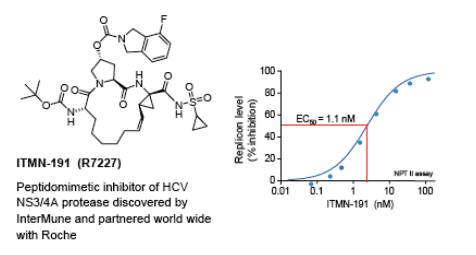
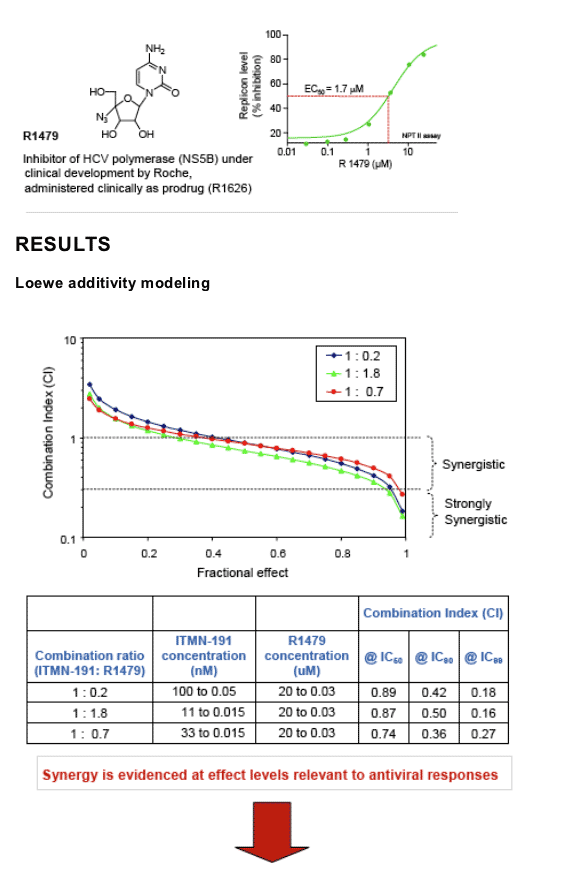
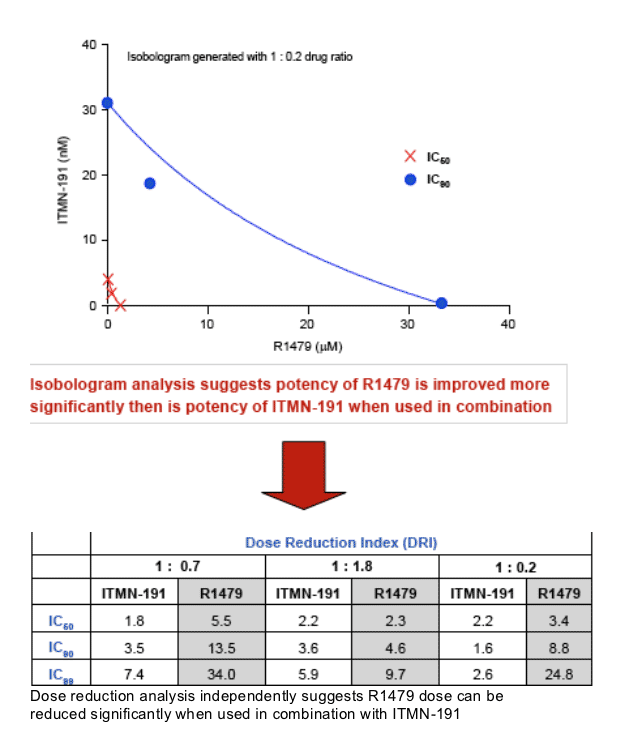
Potency of ITMN-191 improves less than does potency of R1479 when
used in combination
Experiment Design & analysis of synergy
--Two experimental strategies were used to investigate antiviral synergy
--An ELISA-based readout for expression of a selectable marker carried by the HCV replicon was used to monitor HCV replicon levels (NPTII protein)
Loewe Additivity Model:
The dose-effect curves for each drug was converted to median-effect plots
Isobolograms graphically represent additive, synergistic and antagonistic drug effects
Drug Reduction Index (DRI) and Combination Index (CI) were calculated to quantify interdependence of antiviral effects
- DRI quantifies the factor by which the dose of each drug in a combination may be reduced at a given effect level compared with the dose when each drug is used alone. DRI is calculated from the median effect equation taking into account potency (median effect) and the shape (sigmoidicity) of the dose effect curve. A
DRI is associated with each drug in a combination.
- CI takes into account the DRI of each agent: CI = 1/(DRI)drug 1 + 1/(DRI)drug:
- Antagonist effects, Cl > 1
- Additive effects, CI = 1
- Synergy, CI = 1 - 0.3
- Strong synergy, CI = 0.1 - 0.3
Analysis performed in Calcusyn
Bliss Independence Model:
Nonparametric three-dimensional approach to quantify areas where observed effects are significantly greater (synergy) or less (antagonism) than those predicted from single-drug control data
Dose-response curves are generated using a checkerboard design in which drug ratios and concentrations were both varied
Analysis performed in MacSynergy II
Triplicate data sets assessed at the 95% confidence level:
- Minor synergy = values >25 to <50 _M2
- Moderate synergy = values >50 to <100 _M2 (log volumes >5 and <9)
- Strong synergy = values >100 _M2 (log volume >9)
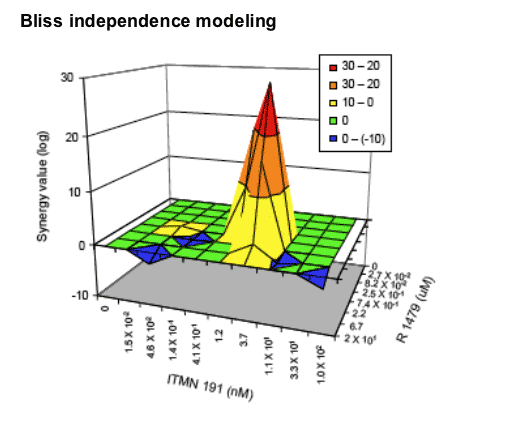
R1479 potency against a HCV replicon with reduced
sensitivity to ITMN-191
HCV replicons were selected for persistence in the presence of 320 nM
ITMN-191 (poster #647)
Replicons selected under these conditions carry NS3 variants of several
types
-- Single substitution of alanine for aspartic acid at position 168 predominates
-- Other variants carry substitution at position 168 plus other substitutions
The sensitivity of this replicon pool to ITMN-191 and R1479 was determined
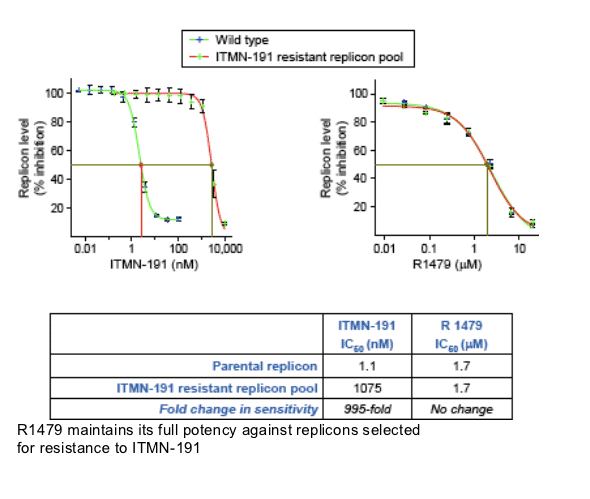
|
| |
|
 |
 |
|
|